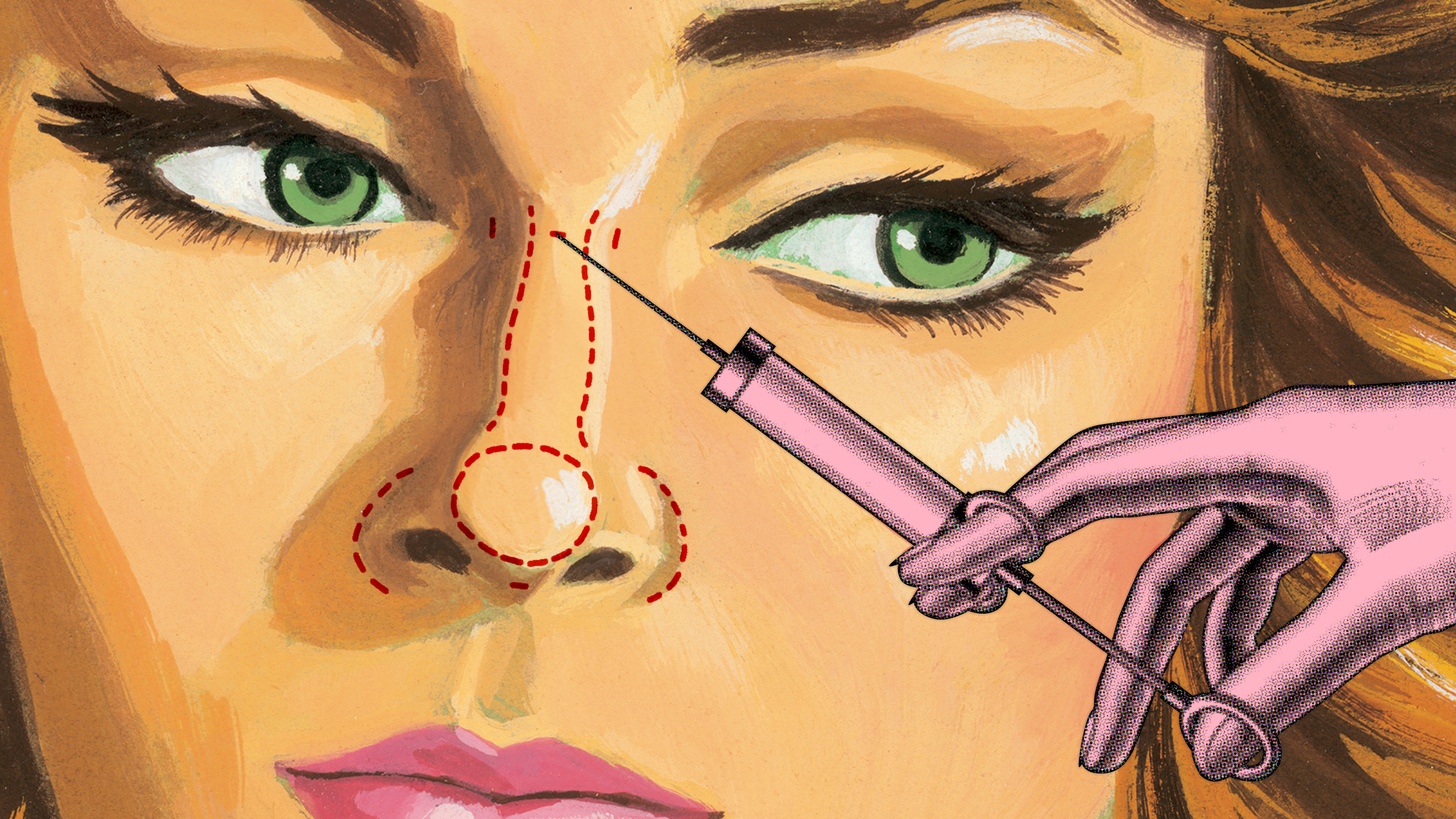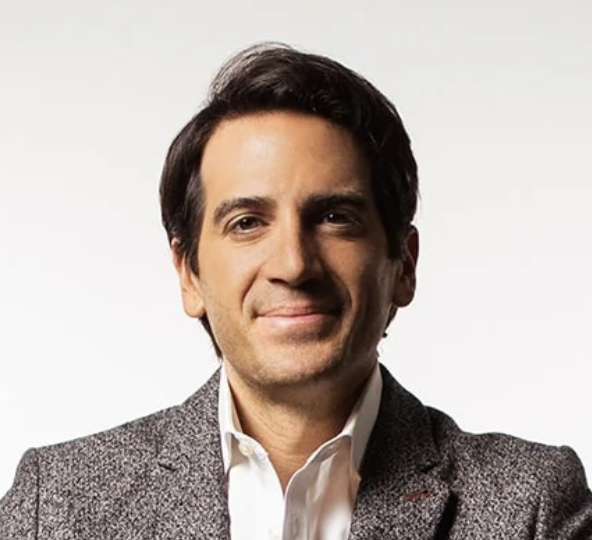You Can Get a Nose Job With Exclusively Fillers
Liquid rhinoplasties don’t require anesthesia, surgery, or $10K. So what’s the catch?


The filler world is a wild one. Sure, there are the basic injections that plump up your lips, cheeks, or chin. You can get dermal fillers in your under eye area, on the back of your hands, or even in your butt (yes, it’s a thing.). More recently though, a new filler treatment is gaining popularity on social media: The liquid nose job. “A liquid nose job, also known as a non-surgical nose job or a liquid rhinoplasty, is a cosmetic procedure in which injectable fillers, such as hyaluronic acid, are used to reshape the nose without surgery,” explains board-certified plastic surgeon Dr. Ira Savetsky. The procedure has been an active player in the plastic surgery realm for nearly two decades, but was largely an if-you-know-you-know alternative. Then, social media swooped in.
#Liquidnosejob has amassed nearly 45 million views on TikTok alone, and is accompanied by some highly convincing before-and-afters videos to boot. Take a cursory glance and it all sounds like a dream: No anesthesia, no scalpel, no major recovery period. I don’t want to make myself the bearer of bad news: But BeautyTok, SurgeryTok, whatever you want to call it, is not a medical authority. Which begs the question: Do liquid rhinoplasties come with a catch?
There are risks—yes; and more than come along with a typical injection. The procedure requires skilled hands, a keen eye, and no matter what the internet says, is not for everyone. That’s not to say you shouldn’t consider it if you’re in the market for a tweakment; liquid nose jobs can be transformative, smoothing out bumps, adding volume, and subtly changing your nose shape. I know: You still have questions. That’s why I tapped Dr. Savetsky, who specializes in liquid nose jobs, to go over the ins and outs of the procedure.
What Is a Liquid Nose Job?
A surgical nose job *might* involve a controlled nose break, the movement of cartilage, improving nasal valves to support clearer breathing, and the reshaping of bones—all depending on the individual. A liquid nose job on the other hand doesn't involve taking anything out of the nasal structure. Instead, your board-certified physician will add filler in an effort to create balance. “The procedure involves injecting small amounts of filler into specific areas of the nose to smooth out bumps or uneven areas, add volume, or change the shape of the nose,” says Dr. Savetsky. “For example, if a patient desires a slimmer nose, the physician may inject filler into the sides of the nose to create the illusion of a narrower bridge. If a patient wants to alter the shape of the tip, the physician may inject filler into the tip of the nose to make it appear more defined and lifted.” In short: The goal is to create a more balanced facial appearance.
That said, just like all filler, it is temporary in nature. Depending on the type of filler your doctor uses, you’ll have a “nose job” for anywhere from six months to two years. “The duration of the effects of a liquid rhinoplasty can vary depending on the type of filler used, the amount of filler injected, and the individual's metabolism,” explains Dr. Savetsky. “Eventually, the filler will gradually break down and be absorbed by the body, and the nose will return to its pre-treatment appearance.”
There’s Actually a Lot of Pros to a Non-Surgical Rhinoplasty
Why would you ever get a liquid nose job, that’s going to poof and disappear in two years max, when you could have a permanent nose job? Phenomenal question. Let’s cut to the answer, shall we? For some people, a temporary timeline is actually ideal. “It’s attractive to individuals who are unsure if they want a permanent change to their nose or who want to try out a new look without committing to surgery,” explains Dr. Savetsky. Some people want to see how they would look and feel with a nose job in a more realistic capacity than AI can offer.
Look at the logistics of it all, and the appeal becomes more understandable. It’s non-invasive (there’s no general anesthesia, no incisions, no operating room) and has no downtime. Don’t go play tennis after your procedure, but according to Dr. Savetsky, you go right back to your daily activities directly after leaving the office. The biggest allure though might just boil down to price point. “Liquid nose jobs are less expensive than traditional rhinoplasty surgery,” he explains, pointing out that a liquid rhinoplasty will run roughly $1,500 to $3,500. A surgical nose job on the other hand can cost up to $15,000.
Stay In The Know
Get exclusive access to fashion and beauty trends, hot-off-the-press celebrity news, and more.
It’s attractive to individuals who are unsure if they want a permanent change to their nose or who want to try out a new look without committing to surgery.
I’m Getting a Liquid Nose Job. What Can I Expect?
Let’s say you’ve already selected your doctor, had your consultation, and now, it’s procedure day. You’ll likely get situated in a room and get numbed up ahead of injections. “The numbing process for a liquid rhinoplasty can vary depending on the individual physician and the patient's preferences, however, the most common method of numbing for liquid rhinoplasty is topical anesthesia,” says Dr. Savetsky. A numbing cream or gel will be applied to the skin and left on until it kicks in. “This method is generally well-tolerated and can help to minimize discomfort during the procedure.”
Then your doctor will discuss your desired outcome, go over logistics, and get to work. “The actual injection of filler usually only takes a few minutes, with the physician using a fine needle or cannula to inject the filler into the targeted areas of the nose,” he adds. You’ll likely be out the door and on your way in 30 minutes.
What Does Recovery Look Like?
Compared to a surgical rhinoplasty, which has a two week recovery period, and requires roughly a year to see final results, a liquid nose job is a walk in the park. You can return to your normal activities pretty immediately. “It's not uncommon to experience some mild swelling, redness, and tenderness at the injection site for a few days after the procedure,” warns Dr. Savetsky. “In some cases, small bruises may also appear at the injection sites, but these can usually be covered up with makeup and will fade within a few days.”
The Thing Is: It’s Not For Everything
That catch we were talking about? Here it is: “A liquid rhinoplasty is not a replacement for traditional surgery in cases where significant changes to the shape, structure, and function of the nose are desired,” says Dr. Savetsky. If you’re looking for a substantial change to nasal structure, a fix for a deviated septum, or a solution to breathing problems, a liquid nose job simply won’t cut it. “It’s best suited for individuals with minor nasal imperfections, such as a small bump or depression in the bridge of the nose, asymmetry, or a slightly crooked nose.” Reasonable expectations make for the happiest outcome, so it’s important to understand that the liquid nose job won’t have as dramatic of an impact as a surgical rhinoplasty.
In order to be considered for the procedure, you’ll also need to have good overall health, abstain from smoking, and be over the age of 18. The latter is extra important to flag, as the nose is not fully developed and therefore should not be toyed with. “There may be further changes in the shape and size of the nose as the individual continues to grow and mature,” says Dr. Savetsky. There may be an exception if a procedure is medically necessary, so it’s always best to consult with your board-certified physician.
A liquid rhinoplasty is not a replacement for traditional surgery in cases where significant changes to the shape, structure, and function of the nose are desired.
Is It Safe?
While the use of fillers for the sake of a nose job is not FDA-approved, it’s been a common, off-label practice for decades. And so long as you go to a reputable provider, you’ll be in good hands. “Performing a liquid rhinoplasty may seem like a simple procedure, but it carries potential risks that should not be taken lightly. While severe complications such as tissue necrosis and blindness are rare, they can occur, and it's important to prioritize safety when undergoing any cosmetic procedure,” says Dr. Savetsky.
You should go to a board-certified plastic surgeon who has A) experience doing liquid nose jobs, and B) experience doing true surgical rhinoplasties. These doctors have a thorough and intense understanding of human anatomy that makes them better equipped to deal with complications. While rare, filler in the nose can lead to blood vessel damage, asymmetry, scarring, an allergic reaction, or infection. For a comprehensive list of side effects, talk to your doctor.
Do I Need to Worry About Migration?
One of the most common filler side effects we talk about is migration. An injection in your lip can get lumpy, something in your cheek can move around—I could go on. Migration is especially unwanted when the end goal is increased symmetry on the nose. So on a scale of one to worried, how concerned should you be?
“The nasal skin is thicker and more adherent to the underlying bone and cartilage than the lips, which can help to hold the filler in place and prevent it from migrating to other areas of the face,” explains Dr. Savetsky. “The nose is also a relatively static structure, meaning that it does not move as much as the lips do during everyday activities such as eating, talking, and smiling, which reduces the risk of filler movement or displacement.” Migration is always a possibility, but it's much less common in the nose than in other areas of the face.
Meet the Expert

Dr. Ira L. Savetsky is a board-certified plastic surgeon who specializes in aesthetic surgery of the face, nose, breasts, and body. His background includes an unrivaled level of education and training in aesthetic procedures, as well as reconstructive, microvascular, and craniofacial surgery. Dr. Savetsky has trained with pioneers and leaders in plastic surgery at some of the most prestigious medical institutions in the world. In addition, he completed a highly competitive plastic and reconstructive surgery residency at the NYU Hansjörg Wyss Department of Plastic Surgery — ranked as the number one training program in the country. Dr. Savetsky is also one of few plastic surgeons in the country to undergo additional fellowship training in advanced aesthetic surgery at the Dallas Plastic Surgery Institute, particularly in facelift surgery and rhinoplasty. This institution is widely regarded as the top aesthetic surgery fellowship internationally.Dr. Savetsky is extensively published, authoring over 50 peer-reviewed publications in top plastic surgery journals and over 30 book chapters in popular cosmetic surgery textbooks. He is also an editorial board member of Plastic and Reconstructive Surgery, the number one academic journal in plastic surgery. With immense dedication to the field, Dr. Savetsky lectures and moderates at numerous plastic surgery meetings and has been recognized with various awards, including the Aesthetic Surgery Education & Research Foundation Grant and the Snyder Award for “Best Paper” at the Plastic Surgery Research Council annual meeting. In addition, Dr. Savetsky serves on multiple committees — including the educational committee, where he helps develop the aesthetic face curriculum for the annual plastic surgery meeting of the American Society of Plastic Surgeons (ASPS).

Samantha Holender is the Senior Beauty Editor at Marie Claire, where she reports on the best new launches, dives into the science behind skincare, and shares the breakdown on the latest and greatest trends in the beauty space. She's studied up on every ingredient you'll find on INCI list and is constantly in search of the world's glowiest makeup products. She's constantly tracking the biggest nail and hair trends to pop up in the beauty space, going backstage during fashion weeks, tracking celebrity looks, and constantly talking to celebrity hair stylists, nail artists, and makeup artists. Prior to joining the team, she worked as Us Weekly’s Beauty and Style Editor, where she stayed on the pulse of pop culture and broke down celebrity beauty routines, hair transformations, and red carpet looks. Her words have also appeared on Popsugar, Makeup.com, Skincare.com, Delish.com, and Philadelphia Wedding. Samantha also serves as a board member for the American Society of Magazine Editors (ASME). She first joined the organization in 2018, when she worked as an editorial intern at Food Network Magazine and Pioneer Woman Magazine. Samantha has a degree in Journalism and Mass Communications from The George Washington University’s School of Media and Public Affairs. While at GWU, she was a founding member of the school’s HerCampus chapter and served as its President for four years. When she’s not deep in the beauty closet or swatching eyeshadows, you can find her obsessing over Real Housewives and all things Bravo. Keep up with her on Instagram @samholender.
-
 Princess Anne's Unexpected Suggestion About Mike Tindall's Nose
Princess Anne's Unexpected Suggestion About Mike Tindall's Nose"Princess Anne asked me if I'd have the surgery."
By Amy Mackelden Published
-
 Queen Elizabeth's "Disapproving" Royal Wedding Comment
Queen Elizabeth's "Disapproving" Royal Wedding CommentShe reportedly had lots of nice things to say, too.
By Amy Mackelden Published
-
 Palace Employees "Tried" to Get King Charles to "Slow Down"
Palace Employees "Tried" to Get King Charles to "Slow Down""Now he wants to do more and more and more. That's the problem."
By Amy Mackelden Published